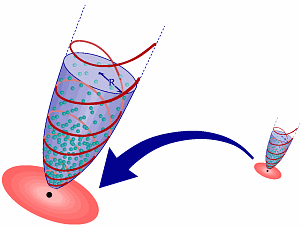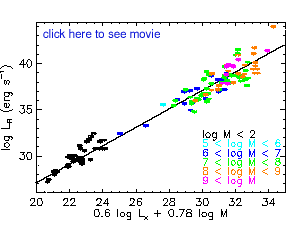 |
|
Figure 1: Artist's impression of black hole - accretion disk - jet
systems in galactic nuclei and X-ray binaries. The appearance of
the inner regions around the black hole is very similar in both
cases, but one is a billion times smaller than the other.
|
|
 |
|
Figure 2: Schematic of the scale invariance hypothesis: To obtain the
properties of a jet from a big black hole (e.g., the magnetic field
strength, shown as red lines, and the density of relativistic
particles, shown as green dots) it is enough to know them for a
small black hole and scale them according to the ratio of their
masses.
|
|
 |
|
Figure 3: A view of the fundamental plane of black hole activity.
Plotted are the radio luminosity
LR and a combination of black hole
mass M and X-ray luminosity
LX, such that the plane is seen
exactly side-on (in other words: the measured correlation coefficients are
0.6 and 0.78, as shown on the x-axis). The colors represent
different mass ranges. To view an animation of the fundamental
plane, please click on the image.
|
|
|  |
Objects as diverse as X-ray
binaries, radio
galaxies, quasars, and even
our Galactic center, are
powered by the gravitational energy released when surrounding gas is sucked
into the black hole sitting in their cores, a process astronomers call
accretion. Apart from copious radiation, one of the manifestations of this
accretion energy release is the production of so-called jets, collimated
beams of matter that are expelled from the innermost regions of accretion
disks. These jets shine particularly brightly at radio frequencies.
The complicated physics of jet
acceleration and collimation close to a black hole is still a mystery.
Yet, the observed similarity (in morphology and spectrum) of jets from
black holes of different mass suggests that they share a common physical
origin. Scientists from the Max-Planck-Institut for Astrophysics have followed
this lead and investigated the consequences of considering all
astrophysical black holes to be members of one single class. They
formulated a scale invariance hypothesis, which states (when translated
into words) that a black hole of a billion solar masses in the
nucleus of a galaxy, surrounded by a large accretion disk and launching a
huge jet into the intergalactic space, can be scaled down by a factor of a
billion and look exactly like a black hole of one solar mass, with its
small accretion disk and jet, like the ones we observe in binary systems in
our own Galaxy (see Figures 1 and 2).
They were then able to derive the underlying
mathematical relation between the emission from jets, the mass of the black
hole, and the rate at which matter is accreted onto it, independent of the
complicated and uncertain nature of jets. Starting from the physical
conditions in the accretion disk (such as the magnetic field strength and
particle density, see Figure 2), it is then possible to predict how bright
a jet from a black hole of given mass and accretion rate will be.
Testing the predictions of the scale invariance hypothesis:
In an effort to test these theoretical predictions, scientists at the
Max-Planck-Institute for Astrophysics have
selected a sample of black holes of the most diverse kinds (according to
the standard classification), spanning a range in black hole mass from
several times the mass of the sun to several billion times that mass, and
containing measurements both in X-rays (probing the highly energetic
accretion disc emission) and at radio frequencies (probing the jet
emission).
In a stunning confirmation of the scale invariance
hypothesis, they discovered that all the active black holes in the sample
followed a simple linear correlation that the scientists called
"fundamental plane" of black hole activity. That is, if one plots the
mass, radio luminosity, and X-ray luminosity for every black hole in their
sample, all the plotted points will lie in a well defined plane (see Figure
3). The existence and the specific orientation of this plane (expressed in
terms of the so-called "correlation coefficients") agree very well with
the theoretical predictions.
The scientists have further demonstrated how a direct
comparison of their theoretical predictions for the correlation
coefficients with more precise future observations can test and rule out
different accretion disk models and how it can measure the coupling between
disks and jets in these most extraordinary and powerful engines of the
Universe.
For further information please contact
Sebastian Heinz or
Andrea Merloni
Links:
This text is based on the following journal articles: http://arxiv.org/abs/astro-ph/0305252
and http://arxiv.org/abs/astro-ph/0305261
Further information about black
holes, accretion, jets, active
Galactic Nuclei, and X-ray
binaries
can be found at NASA's
outreach pages and at their "ask
an astronomer" page.
|